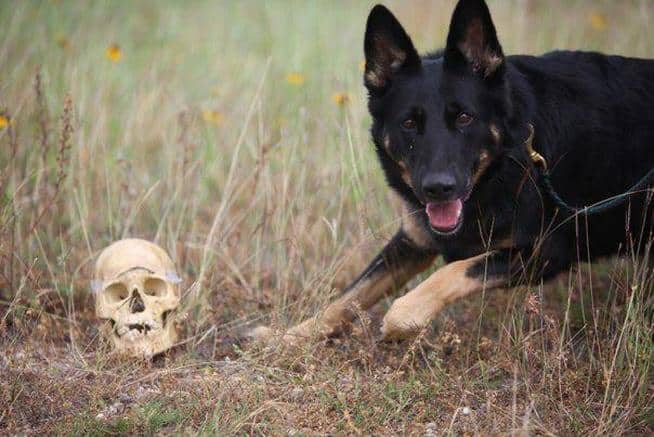Dogs have been human companions for centuries, and their loyalty and affection are well-known.
But dogs are not just pets—they can also be trained to perform a variety of tasks.
For example, guide dogs help blind people navigate safely and dogs can also be trained to detect explosives or illegal drugs, making them valuable members of law enforcement teams.
Some dogs even serve as search-and-rescue dogs to find missing persons while others are trained to search and retrieve human remains.
Human remains detection is another extraordinary area where dogs excel. Using their superb sense of smell, cadaver dogs can locate the missing and dead in different environments.
This excellent skill helps the police, detectives, and search and rescue teams track down human remains in the aftermath of disasters, murders, and suicides.
Using well-trained cadaver dogs, searches can be conducted with a high level of accuracy and have a high chance of success.
In this post, we will provide an overview of cadaver dogs, their history, and what makes a dog the perfect candidate for finding human remains.
We will also highlight the dog breeds that can make great cadaver dogs and discover how accurate these dogs can be in resolving missing or diseased person cases.
Finally, to keep you up to date with these amazing dogs, we will discuss their costs, some of the ethical issues surrounding their roles, and some of the famous cadaver dogs in history.
Let’s dive right in…
What is a Cadaver dog?
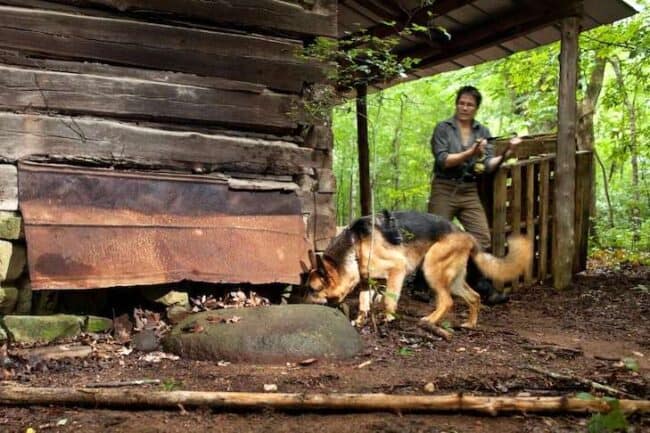
A cadaver dog is a specially trained dog that is used to detect the presence of human remains.
The dogs are trained to use their sensitive noses to identify the unique scent of decomposing bodies, and they are often used in cases of missing persons or suspected foul play.
Cadaver dogs have been instrumental in solving numerous cold cases, and their services are often sought by law enforcement agencies and private individuals alike.
Decomp dogs, which are trained to identify the scent of human decomposition to help forensic anthropologists determine the time since death, can also be considered to be cadaver dogs.
While the use of cadaver dogs is not without controversy, there is no denying their efficacy in locating hidden bodies.
For this reason, cadaver dogs remain an important tool in the search for justice.
Read: How to Become a Cadaver Dog Handler
History of Cadaver Dogs

The use of dogs to locate human remains is not a new phenomenon. In fact, the practice dates back centuries, and there are historical instances of dogs leading their handlers to missing people who were presumed dead.
The most notable example is when a German court clerk used his dog in 1809 to search for two girls who had vanished mysteriously.
Even though this dog didn’t have specialized training, it led the court clerk to a woodshed and when police searched it, they recovered the bodies of the missing girls. This helped the police to gather more evidence which helped them apprehend the killer.
Dogs were also used to locate fallen soldiers in World War I and due to their impressive accuracy, they were brought back into action in the Second World War.
But the use of cadaver dogs gained popularity in the United States in the 1970s when Law enforcement agencies started depending on them to solve cold cases.
By the 1980s, cadaver dog was commonplace in law enforcement. For instance, the Connecticut state police reportedly trained their canine unit to not only serve as patrol dogs but also for purposes of retrieval of missing persons who were presumed dead.
Today, dogs are almost always used to find missing persons and they are not only used by law enforcement but by private citizens as well.
What Makes A Good Cadaver Dog?
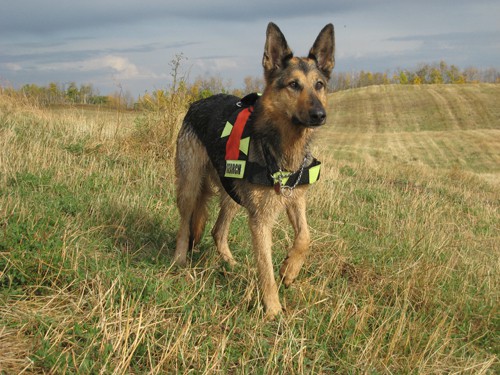
Certain characteristics make a dog more likely to succeed as a cadaver dog:
A. Good Sense of Smell
To begin with, the dog must have a good sense of smell. This is essential because the dogs rely on their sense of smell to detect human remains.
Even though all dogs have an impressive sense of smell, some breeds are more adept at this task than others.
For instance, the British Bulldog doesn’t have as good a sense of smell as the Labrador retriever.
B. Trainable and Obedient
Secondly, the dog should be trainable and obedient. This is important because the dogs need to be able to follow commands to be effective in their searches.
When out on a mission, dogs are expected to sniff out the remains and then signal their handler without causing a disturbance.
If a dog is not obedient to its handler, he will easily contaminate the crime scene. Additionally, disobedient dogs could just as easily lead their handlers in a wild goose chase.
C. Calm and Gentle
A cadaver dog should also be calm and gentle. The dogs will often be working in emotionally charged situations, and they need to be able to remain calm to be effective.
D. Good Stamina
Cadaver dogs should also have stamina and a good level of fitness. Sometimes searches can often be long and strenuous, and the dogs need to be able to keep up with their handlers.
Additionally, the dogs should be able to work in a variety of environments and weather conditions.
Human remains can be found in a wide range of locations, and the dogs need to be able to work effectively in all kinds of terrain and weather.
Best Cadaver Dog Breeds

There are certain breeds of dogs that are more likely to succeed as cadaver dogs than others.
Let’s have a look at some of them below:
1. German shepherd
German Shepherds were originally bred to be herding assistants and they are known for their intelligence, loyalty towards owners, and courage in harsh weather conditions like snowfall or heavy rain.
These canines have evolved from farm animals into serious law enforcement assistants.
Their hardiness, intelligence, and trainability make them a great choice for cadaver dogs.
2. Golden Retrievers
Golden retrievers are known for being extra cuddly, gentle, and friendly with everyone but don’t let that fool you because they can also be hardy and perfect for search and retrieval.
Golden retrievers are some of the most obedient dogs and they will therefore pair very well with their human handlers.
These coupled with their impressive sense of smell, makes them one of the best breeds for cadaver dogs.
3. Labrador retriever
This breed is known to be highly trainable, obedient, and intelligent.
They are also very friendly, making them good around people, which is a good quality to have when doing a search and retrieval mission.
Labrador retrievers have a great sense of smell and they are also relatively athletic, meaning they can keep up with their handlers on long and strenuous searches.
4. Border Collie
The Border Collie is an easy-going dog breed that is always eager to please.
They are also very intelligent which means they can easily be trained to understand and follow implicated commands.
These intelligent and trainable dogs are also very energetic, so they won’t tire easily when out on a hunt for human remains.
As a bonus, these dogs are also known to be very calm and gentle, so the handlers can count on them not to get feisty.
5. Dachshunds
Dachshunds were originally bred as guardians for castles in Germany and Switzerland where they were used against enemies outside those barriers – just like how service dogs are sometimes utilized today!
These dogs, therefore, have natural stamina that will make them good cadaver dogs.
They also have an impressive sense of smell which can be put to good use with the right training.
Even though these are the commonest cadaver dog breeds, other breeds can still be trained and used as such. As long as a dog has a keen sense of smell and is tenacious enough to go on a long hunt, it will do just fine.
How Are Cadaver Dogs Trained?
Cadaver dogs are usually trained using a method known as “scent discrimination.”
This involves training the dog to distinguish between the scent of a live person and the scent of a dead person.
The dogs are first trained to recognize the scent of a dead person by being exposed to human remains.
Once the dogs have been exposed to the scent of a dead person, they are then trained to follow a trail of that scent.
Cadaver dogs are trained to detect the “smell of death” which is typically caused by a chemical called cadaverine.
Cadaverine is what makes a dead body smell bad and it is also found in semen and urine.
Other chemicals these dogs are taught to identify are Putrescine and Skatole.
Putrescine smells almost like Cadaverine and it’s the same compound responsible for bad breath while Skatole is primarily found in feces.
By identifying any of these chemicals, cadaver dogs can easily locate a dead person.
When cadaver dogs find human remains, they will usually sit down next to the remains and stare at them.
This is known as a “passive alert,” and it is how the dogs indicate that they have found something.
The dogs will then wait for their handlers to come and confirm that the remains are indeed human.
They are trained to give a “passive alert” to prevent them from jumping all over the crime scene and contaminating the evidence.
How Much Does It Cost To Train A Cadaver Dog?
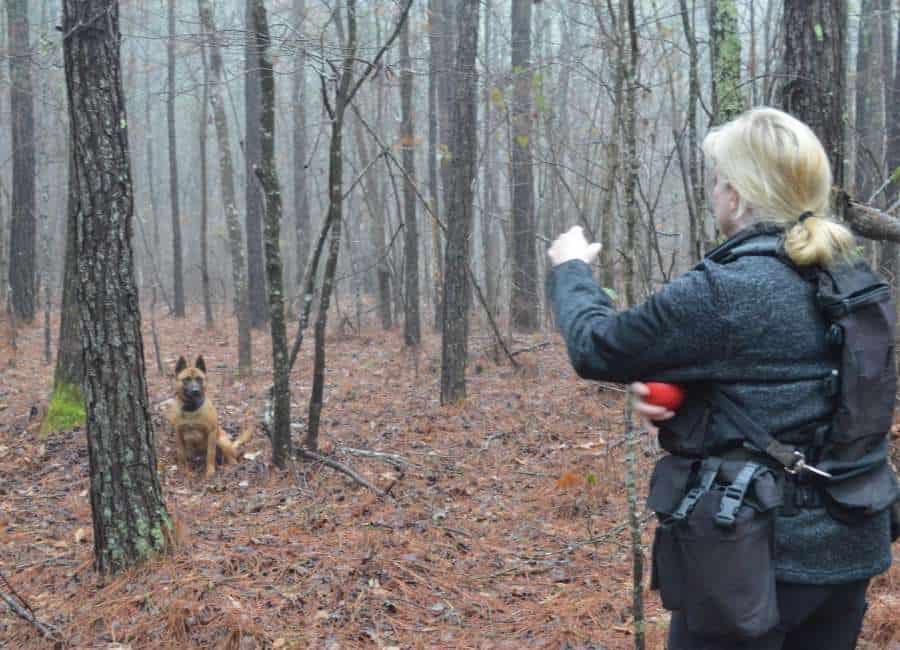
The exact cost of training a cadaver dog will vary depending on where you train your dog, what kind of training they get, the age of the dog, and the breed.
However, according to Search and Rescue Dogs of the United States, a professionally trained dog will cost around $10,000 and it will take a total of two years to complete the training.
This is assuming that the dogs start the training as puppies because older dogs are harder to train.
During this time, the dog will not only be trained to sniff out dead people but will also be trained to be obedient to their handlers.
Can I train my dog to be a cadaver dog?
Well, it is possible to train your dog to be a cadaver dog but only if you know how to train a dog or with guidance from an experienced trainer.
However, it is important to note that not all dogs will be suitable for this type of work.
The best way to determine if your dog has the potential to be a cadaver dog is to consult with a professional cadaver dog trainer.
How Accurate Are Cadaver Dogs?
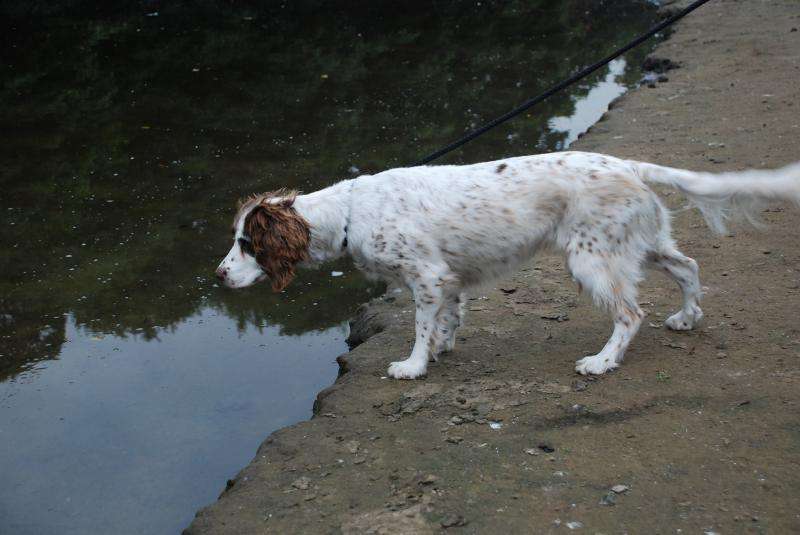
Even though some experts have raised concerns about the use of cadaver dogs, there is no denying that these dogs are very accurate.
Research shows that cadaver dogs have a 95% accuracy rate when it comes to detecting human remains.
However, the accuracy will depend on how well-trained the dog was. If they got good training, you can almost always expect high accuracy.
The accuracy of the dog can also be influenced by their handlers. Handlers are also trained to understand their dog and they should be able to decipher when the dog is sure of a find or when they might just be false alerting.
A good handler will also know how to read the dog’s body language and this can play a big role in the accuracy of the search.
A story reported by the New York Times is perhaps one of the best testaments of cadaver dog accuracy.
According to the report, police revived a 33-year-old cold case when a cadaver dog reportedly sniffed the remains of what the police believed to be a 9-year-old that had vanished 33 years earlier.
This means that dogs cannot only accurately sniff out the remains of deceased people but that time doesn’t even matter.
As a matter of fact, a recent study found that dogs are capable of detecting human remains that are over 3,000 years old.
As a result, archeologists have since started using dogs to find ancient settlements.
The fact that cadaver dogs can detect human remains to depths of 15-20 feet (6 meters) is what makes them great for archeological explorations.
Incredibly, these dogs can also detect human remains that are submerged in water to a depth of 30 feet. This means that they are not only used on land but also in water for search and retrieval operations.
In addition, they are not only trained to recognize decomposing tissue and blood but they can also locate human bones as well.
In fact, this ability to locate human bones is what has made archeologists start relying on cadaver dogs in their work.
By using cadaver dogs, archeologists can unearth the remains of human settlements that are hundreds or even thousands of years old.
Additionally, the police can use cadaver dogs to find bodies that were lost years ago and thereby solve lots of cold cases.
Cadaver dogs are also trained to differentiate between animal and human remains. This reduces false positives during a search and retrieval mission.
When on a trail, these dogs will ignore all other scents of dead animals and birds and just focus on picking any scent from a dead human.
This is made possible by training the dogs to recognize chemicals that are only found in human remains such as Cadaverine and Putrescine.
Interestingly, cadaver dogs can also detect human ashes. Human cremains, as they are called, can actually retain a scent for up to several years after cremation. The high temperatures reached during cremation don’t break down all the cells in the body.
So, it means that there will still be some cells remaining that contain the person’s DNA and it is these cells that cadaver dogs can detect.
Arguably, the only limitation when using Cadaver dogs to retrieve lost people is that they may not help locate those who are alive.
The dogs have been trained to block out any other scent and only focus on the “smell of death.”
Ethical Issues with Cadaver Dogs
The biggest ethical concern is how cadaver dogs are trained.
One of the most effective methods used to train cadaver dogs is the use of human body parts.
While some experts argue that this is the most effective way to train these dogs, others believe that it is unethical and humane.
Those in favor of using human body parts to train cadaver dogs argue that it is the best way to ensure that these dogs can accurately detect human remains because the scent of human remains is very different from that of animal remains.
As a result, these dogs need to be exposed to this scent for them to be able to accurately identify it.
Those against the use of human body parts argue that it is unethical and inhumane.
They believe that it is not right to expose these dogs to the scent of death at such an early age.
In addition, they argue that there are other ways to train these dogs that do not involve the use of human body parts.
Additionally, cadaver dogs have to go through approximately two years of training which entails exposing them to the foul death-like smell of decomposing human flesh day in and day out.
Even though the training is done by professional trainers who have a lot of experience in dealing with these dogs, it can still be quite tough on them considering that the dogs are constantly exposed to the foul smell of death which can be quite traumatizing.
Granted, once the training is done, the dog will have acclimatized to the foul smell and will be very good at searching and retrieving dead bodies.
But the means of getting the dog to this point is what raises eyebrows with some arguing that it is too cruel.
How Much Is A Cadaver Dog?

The cost of a cadaver dog varies depending on the breeder, trainer, and country.
If the estimate by The Guardian is anything to go by, cadaver dogs can cost anything from $5,000 to $10,000.
But this is just a ballpark figure and the dog can cost even more. For instance, CNBC reports that some companies sell specially trained dogs for as much as 230,000.
This cost is high because the canines have to go through specialized training and care which is quite expensive.
In some cases, the dogs are trained overseas before they are imported which makes them even costlier.
The steep cost of these dogs may also explain why cadaver dogs are almost exclusively used by law enforcement—although private citizens who can afford them are not prohibited from owning them.
How Many Cadaver Dogs Are There in the US?
There is no accurate estimate of how many cadaver dogs there are in the US.
However, considering that these dogs are mostly used by law enforcement agencies, it is safe to say that there are at least a few hundred in law enforcement alone.
This figure is just an estimate because law enforcement agencies do not have a public figure of how many cadaver dogs they own.
According to Koenig Marcia, who is one of the founding members of the American Rescue Dog Association, there are not less than 500 civilian canine search teams.
It would be safe to infer that these teams rely on cadaver dogs and that each team has at least one dog.
This would mean that there are at least 500 cadaver dogs that are not owned by law enforcement agencies.
Do Cadaver Dogs Get Depressed?
Yes, cadaver dogs can get depressed.
According to Psychology Today, Cadaver dogs can show signs of depression when they find dead people. These signs include lethargy, loss of appetite, and avoiding people.
Considering the kind of training they are subjected to, it is no wonder that these dogs can get depressed.
Some experts believe that the reason for depression is that they do not feel rewarded when they find a dead body.
In fact, some handlers often train their dogs to find living people just to lift their spirits.
The Depression of cadaver dogs is a major concern among animal activists and is one of the reasons cited for the push to stop using these dogs.
However, some argue that the dogs are usually sad due to the nature of the job but they are trained professionals and do not actually get depressed.
Famous Cadaver Dogs
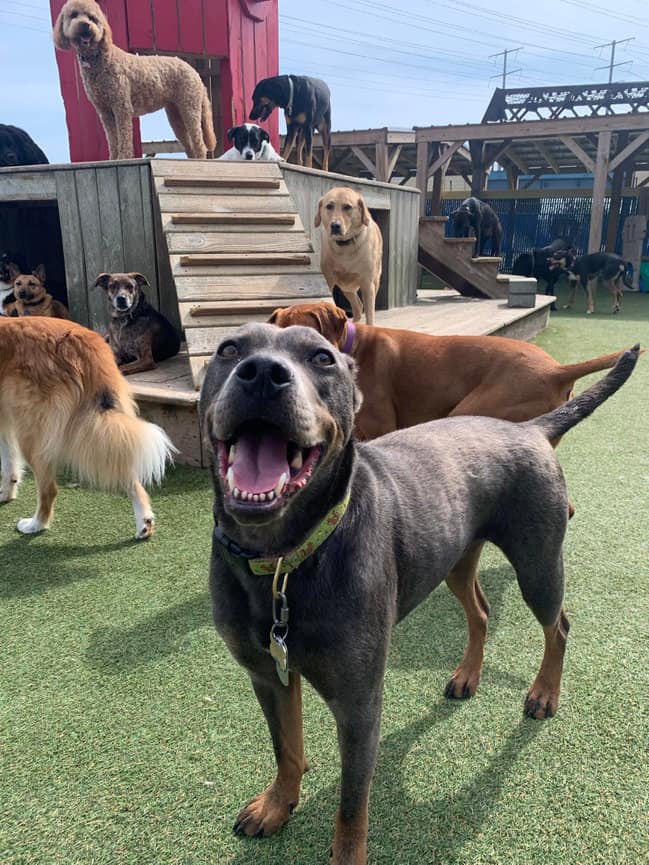
Many famous cadaver dogs have helped in the search for missing people and in solving crimes.
Some of these famous dogs include:
I. Sully the Rockstar:
Sully, who has since retired, was the hero in the Douglas Garland triple murder trail in Canada.
CPS’s k-9 unit was able to retrieve body parts of the victims, thanks to Sully, who was nicknamed “the rockstar” after this case.
According to his handler, the dog doesn’t even know he is doing police work because he considers the process of finding dead bodies a game.
II. Eddie and Keela
When the police in Portugal hit a dead end in their investigations into the disappearance of Madeleine McCann, Eddie and Keela came in to save the day.
These two cadaver dogs worked together to lead the police to the car she rented and the hotel she stayed in just before her disappearance.
Although they didn’t get the bodies, the dogs helped them get new DNA evidence which police are optimistic will lead them to the culprit.
III. Buster:
Buster and his handler Dostie Paul made news when they found what is believed to be the remains of Kristen Modaferri, who had vanished 18 years earlier.
Upon further investigation, it was unearthed that Kristen lived at the apartment building which is located in Oakland, California, and this led police to believe that they had indeed found the remains.
Buster had been very successful in identifying bodies of fallen soldiers in war-torn regions but he is now used locally to help police in search and retrieval.
IV. Sherlock Bones
Even though his real name is Buster, he has since been nicknamed Sherlock bones because this cadaver dog has been used to successfully find and retrieve over 200 dead bodies.
The most notable of his finds is when he found the remains of a World War II pilot who had crashed in 1944 in Belgium.
Sherlock Bones has thus helped solve many missing person cases that had gone cold over the years.
Conclusion
Cadaver dogs are an important tool in the search for missing persons and crime scene investigation.
They are trained to use their keen sense of smell to detect the presence of human remains, even when those remains are well hidden.
While cadaver dogs are not infallible, they have proven to be invaluable in many cases.
Even though there are lots of ethical concerns surrounding their use, there is no denying that these dogs have helped law enforcement close cold cases and convict dangerous criminals.
As an Amazon Associate, we may receive a small commission from qualifying purchases but at no extra cost to you. Learn more. Amazon and the Amazon logo are trademarks of Amazon.com, Inc, or its affiliates.

